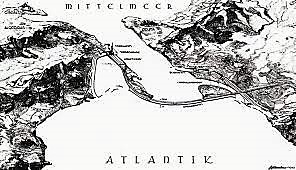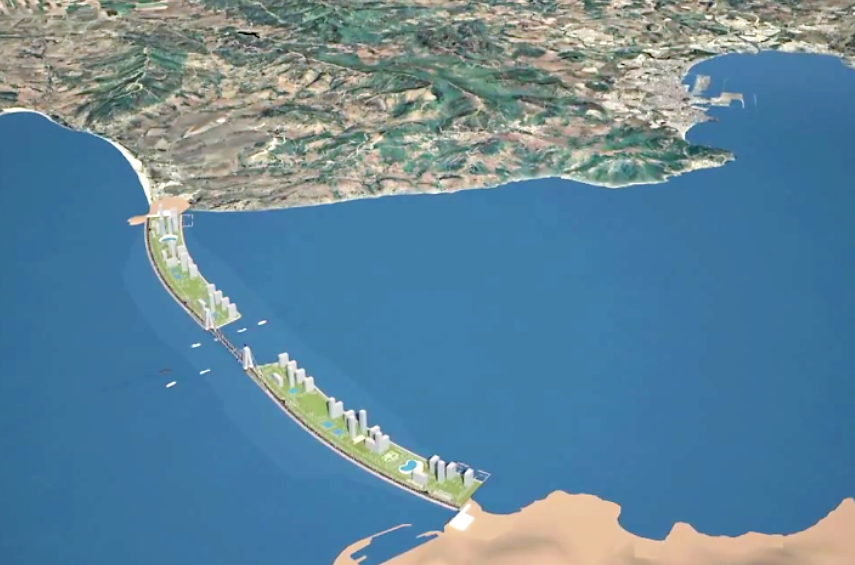Patricia Morcillo Sanz. Student at ETSI Caminos, Canales y Puertos.
Any civil engineering project, because of its scale and magnitude, changes the ensemble of the territory and its landscape, causing actions on the environment and population. Taking this into account, at the beginning of the century, Hermann Sörgel, a German architect, outlined the construction of an enormous dam in the Strait of Gibraltar with the objective of draining part of the Mediterranean Sea and installing a hydroelectric power plant to produce 50.000 megawatts of electric energy. Furthermore, it would join the European and African continent, as a result of a fall of the sea level (100 m in the western side and 200 m in the eastern side). Therefore, 660.000 km2 of land could emerge creating a new continent, Atlantropa, where people could search for peace after the World War II and sectors such as economical, industrial, resources or raw material could be pushed forward. Sörgel was inspired by Wells’ map where he detailed his theory of the formation of the Mediterranean Sea and the existence of an ancient continent which was simitar to Atlantropa.
This project was based on the research elaborated by Intitut für Meereskunde (University of Berlin). The research explained that the contribution of the Atlantic Ocean, the Black Sea and different river basins were lower than the evaporated volume that was estimated. Consequently, if the sea was regulated and the contributions controlled, a constant and slowly evaporation would take place (4.144 km3 per year or a reduction on the sea level of 165 cm per year). In addition, the massive desalination could allow the irrigation of the Sahara, turning it into a productive land. To help to get it, a big lake in the Congo basin would be created which would be connected to Chad lake. Moreover, this large water mass could compensate the loss of weigh produced by the drainage of the Mediterranean Sea and it could turn African climate into a more moderated and nicer climate for European people. Also, he explained a plan for ancient port cities that could be joined together with the remanent sea using inside canals. However, although people at the time admired the search for peace and progress, Sörgel was criticized because he didn’t examine correctly the consequences of this impact in the abiotic and biotic environment.
The most obvious consequences could be on the physical environment, in particular in biotic environment. The climate would be affected because a reduction of the precipitation in the Mediterranean basin would be produced the change of the low- and high-pressure cells as happened in the Messiniense Salinity crisis, when Strait of Gibraltar was closed because of tectonic movements, causing this variation and achieving as a result a thermal increment of 3 ºC and an increase of salinity, rising the dryness and the desertification in some areas as Sahara. As the land would become a drier place where any plant would be difficult to grow and land would be easily eroded because it wouldn’t be phytostabilize, sandstorms would take place such as with the drain of Aral Sea due to anthropogenic effects or Dust Bowl crisis in EEUU, that blocked the use of productive land as well as the creation of new fertile land, transforming it into a barren or uncultivated land and becoming the opposite situation of what Sörgel was looking for. Also, it would affect the Atlantic Ocean that would see modified its salinity, temperature and sea currents. Moreover, it would disrupt the geomorphology and geotechnic because the loss of weigh of this giant mass of water would make the system unstable, increasing the possibility of earthquake and volcanic eruption. This earthquake would break the dam causing tsunamis that would destroy the zone. Regarding biotic environment, in addition to the effects in flora that have been just explained due to the lack of precipitations, one of the most affected agents would be the fauna, because even if the damage in the sea environment where the dam would be located and the increase of salinity that would affect the ecosystem or habitat of species were not kept in mind, the dam would be a corridor between the two countries, allowing species to migrate that could take up the ecological niche of native species. Furthermore, due to the change of coastline, the rivers and its deltas that flow into the Mediterranean Sea would be modified, affecting the hyporheic zone and multiples species that live in it. Additionally, the river equilibrium profile would be altered and the river would react with shocking erosive dynamics.

For its part, socioeconomic environment would suffer big variations too: there would be a new populational distribution (migration to the new cities) and the land use and its property would change that could affect to the pacific relationships because different countries could reclaim the property of the new land and dam (a big energetic and economical resource).

Nowadays, Sörgel’s idea has been resumed with the planning of a bridge-dam that would be a protection step against the sea level rising due to climate change. This measure has been introduced as a benefit for the combination of Mediterranean counties in which many lands would be flooded. In addition, it would be a link between Africa and Europe. Nevertheless, as in Sörgel’s dam, the effects on the physical environment need to be studied because, although the promotor says that the benefits would be better that the caused effects (dykes where spices could maintain its habitat have been planned), it would necessary to examine what percentage of species could survive in presence of this distress or what the affection level to other species and ecosystems that are indirectly influenced and were not taken into account in the project could be (the affection spatial field is wide).
And what about you? Do you think that a project like that would be viable?

Un comentario
Escriba un comentario →